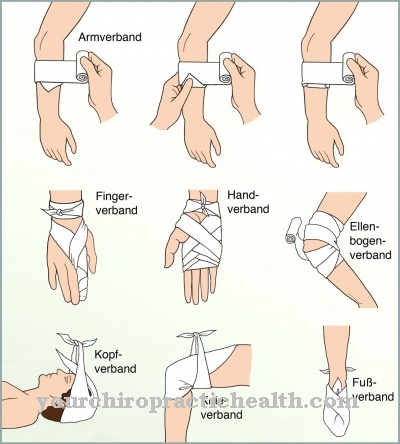The Echocardiography is the ultrasound scan of the heart. The examination method, also known as "heart echo", is non-invasive and very gentle, which enables the detection of heart defects even in unborn babies who can then be treated in the womb.
What is echocardiography?

In the Echocardiography there are two different variants: the TEE (transesophageal echocardiography) and the TTE (transthoracic echocardiography).
With TEE, the heart is examined using an endoscopic probe into which an ultrasound head is integrated. The probe is inserted through the esophagus of the fasting patient. In contrast, with TTE the examination is carried out from the outside via the chest.
With this method, the patient is examined in a slightly left lateral position with a slightly raised upper body with a small transducer that is placed in different positions in the chest area. If the acronym "echo" is used, the second form of echocardiography is usually meant.
Function, application, effect & goals
With the Echocardiography a real-time image of the heart can be shown. It is of great importance in assessing the size of the heart and its function. With this procedure, all movements of the heart, including the functionality of the heart valves, can be made directly visible.
The sizes of the atria, heart chambers and heart valves can be measured and it can be assessed whether all areas of the heart walls are regularly involved in the heartbeat and whether the heart valves are opened and closed at the right time or whether they are narrowed or leaking.
Different display methods are used in echocardiography: the one-dimensional M-mode procedure, the two-dimensional B-mode procedure and the color-coded two-dimensional duplex sonography. In color-coded echocardiography, the blood flow towards the transducer is displayed as a red cloud, while the flow away from the transducer is displayed as a blue cloud. This shows the direction of blood flow. In addition, this mode of representation makes it possible to estimate in an echocardiography how great a leak is.
Thanks to special techniques such as Doppler echocardiography, it is also possible to determine the speed of the blood. By measuring the flow velocity and detecting flow accelerations, it can be examined whether the heart valves are functioning normally or whether there is a constriction or a leak.
Another form is stress echocardiography, which enables the assessment of cardiac function under stress and can provide information on coronary heart diseases or diseases of the heart muscle. For this purpose, the heart activity is increased before the echocardiography either by means of physical stress or by a drug.
Depending on the method used, echocardiography allows a wide variety of statements about the nature and function of the heart. In this way, the size of the heart cavities (atria and chambers) and the thickness of the walls and the septum of the heart can be determined. The assessment of the pumping function or the performance of the heart is also possible. These are, for example, for assessing the extent of heart failure.
Movement disorders of the heart that can occur as a result of a heart attack can also be identified by means of echocardiography. The function and shape of the heart valves and the diameter and shape of the aorta can also be measured, as can changes in the pericardium, especially the size and scope of a pericardial effusion. The blood pressure in the pulmonary artery, the increased values of which can indicate pulmonary hypertension or a pulmonary embolism, for example, can also be estimated. Echocardiography can also be used to detect congenital heart malformations at an early stage.
Risks & dangers
Generally speaking, the risks with a Echocardiography low. The standard method from the outside poses no dangers and is not unpleasant either. With transesophageal echocardiography, unpleasant symptoms such as the gag reflex and increased salivation cannot always be avoided, as these are very natural reactions of the body to a foreign body, in this case the probe.
During the examination, side effects from the administered local anesthetics may occur in some cases.Vessels, tissues or nerves are more rarely injured when the tube is pushed through the esophagus.
Injury to the throat and esophagus, and the resulting bleeding and infection, are considered the main risk in echocardiography. With careful consideration by the doctor, however, the advantage of the examination using echocardiography outweighs any complications that may arise many times over.
























.jpg)



